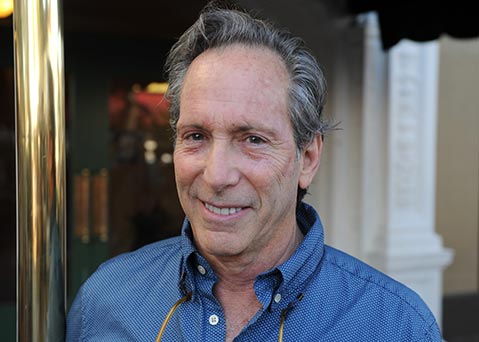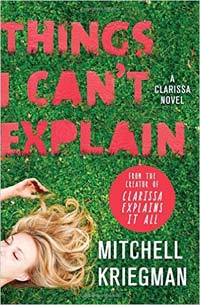Mitchell Kriegman Brings Clarissa Back to Life
Author Writes New Book About Character All Grown Up

More than 20 years ago, my wife and I fell in love with Nickelodeon television show Clarissa Explains It All. We pretended to watch with our grammar-school-aged son, Zac, but truth be told, we continued to watch it long after he lost interest. Clarissa was everything my spouse Diane wished she was when she was 14: killer fashion sense (Clarissa invented the mismatched-prints-with-Doc-Martens look), confidently smart, opinionated (glib even), and quite capable of defending her strongly held eccentric ideas with fun, quirky logic.
I watched the show for some of those same reasons, but also because growing up fully television-ated in the Golden Age of family sitcoms (Leave It to Beaver, Father Knows Best), I was utterly fascinated that the show’s originator Mitchell Kriegman and his writing team (including Suzanne Collins, who would later write the Hunger Games books) could repurpose the TV family dynamic so thoroughly. The parents were surreal but functional incompetents, while the children worked triple hard at making things make sense, even if they often reached nutty conclusions. Clarissa had a running commentary on whatever she felt or was thinking, and those thoughts were often more interesting than the sitcom “problems.” Besides, there was Sam, a neighbor boy with a ladder into Clarissa’s bedroom and heart. The innocence of their friendship was matched by the ardor of respect they held each other in — it was unlike anything else on television, and funny to boot.

Diane, a teacher, was so taken with Clarissa’s liberated savvy that she would tell mothers with pubescent girls, “Oh, you should Hulu it and show your child this TV program; the girl character is so great!” She even confesses emulation of Clarissa’s stretch-the-fashion-boundaries sense, though adapted for an age-appropriate look.
Imagine our excitement to learn that Kriegman lives in Santa Barbara — he moved here to raise his own children and to write books; he also writes for this paper — and, even better, that he was engaged in writing a book about Clarissa older, brought back as herself but, to put it crudely, the way she does in the book, after her V-Card was taken. The girl is a woman now. Add to this the full cast of familiar characters. Parents separated. Dad, who used to call her “Sport,” is apparently dismayed the kooky mom Janet is now a millionaire. Clarissa’s obnoxious brother is a kind of criminal, and her Sam is love realized but strangely gone missing.
Kriegman’s own excitement about the book was mixed with nervousness two weeks ago, just as the book, Things I Can’t Explain: A Clarissa Novel, was about to appear in stores. For one thing, it’s much different writing a novel than writing television, more solitary an endeavor, demanding more psychological truth. “I wanted to keep everything about her, only make her older,” said Kriegman over lunch downtown, “with all that involves. We didn’t do a show about sex. We avoided sex altogether.” He doesn’t hide from it in Things I Can’t Explain. In fact, besides a gamut of adult boyfriend problems, one of the best scenes in the book is an unabashed sex-in-a-car scene that might leave some readers shocked, though it is handled with utter sensitivity. “I wanted to bring back the purest, cleanest version of her,” Kriegman said. “But I always wanted to go much deeper into her character than five seasons allowed us to.”
Kriegman always wanted her back. “I never wanted her to go away,” he said. It was the network itself that pulled the plug just as he was ready to really dig in, he said. Ironically, it was Nickelodeon’s carte blanche attitude in the beginning that brought Clarissa into being. Kriegman had been a performance artist and a Saturday Night Live writer and took meetings with Nick exec Gerry Laybourne, who was looking for creative pitches and a flagship character for the lineup. Kriegman argued it ought to be a girl. When the series premiered, sponsors got an immediate boost for both GI Joe and Barbie sales; she appealed to both sexes, Kriegman said.
Her character developed quickly. “Initially we imagined her a little snarkier,” said Kriegman, who had synthesized the show’s format from a lot of other comic creations he admired. “But then the sweetest, nicest person in the world showed up, Melissa Joan Hart.” Kriegman readily admits that Hart, who later played Sabrina, the Teenage Witch, helped form Clarissa’s psyche, though not her fashion sense. “She couldn’t pronounce Freud or even Tibet at first,” said Kriegman who loves Hart and loves the idea of writing for specific performers.
But a novel doesn’t allow many aspects of the show that fans loved. Like that crazy guitar chord that played whenever Sam appeared. “It’s also harder to convey her fashion sense in a book than it was in television,” said Kriegman, who got lots of input from friends like Lisa Lederer, the wardrobe consultant on the show, to update Clarissa’s look on the page. Kriegman was the author of last year’s Being Audrey Hepburn, another book that used fashion as magic and metaphor, so his chops are brushed up. Things I Can’t Explain best conveys Clarissa’s passion in a shopping sequence where she discovers the perfect dress in a vintage shop. Kriegman’s prose sanctifies Clarissa’s costume urge both as escape and self-expression. Better yet, the grown-up fiasco disaster that follows is hilarious and horrible.
This is Clarissa on the page, though Kriegman knows some fans might not like where he’s taken her, and the title underscores how her maturity has undermined the famed rationalizing moments. Spouse Diane felt Clarissa lost some of her old assertiveness, while I found the new problems much more moving to watch unfold. The Sam backstory, though, will probably anger a few people.
We meet the new Clarissa living in the Financial District of Manhattan a short time after the newspaper she worked for closed. She’s between jobs and boyfriends, and then her parents show up unexpectedly. Meanwhile, there is the patented chatter with graphs and lists and, in one brilliant passage, Clarissa diagrams a sentence spoken by a pretentious male. And now here she is back among us, sort of grown-up. “Like I said, I kept everything, but I wanted her to be older. I wanted the book to be a little lighter than it is, but it’s harder to be light in a novel, like it’s harder to be darker on a television show.”
There are many brilliant moments in the book — the Ferguson (Fergbreath) subplot seems harsh at first but gets better. Clarissa is tougher, wiser, and still windy. There’s a moment when Clarissa looks back on her “Explains It All” period (many in-jokes fill the book) and says, “I coasted so smoothly through those tween years. I was better than the game. My goal in life was to be the star of my own reality, as opposed to a reality star.”
It will be exciting to see what the people who grew up with Clarissa think. Kriegman is waiting to see, too. “You know, she was a lot like Bugs Bunny; she had resilience,” he laughed. “She never lost her cool. My opinion? I think her character was ready for something more than nostalgia. These are new versions of old things. She’s reaching for new meanings from old material, and I didn’t want to do a campy revival show. You’ve got to be true to the brand.”
4.1.1
Mitchell Kriegman will sign copies of Things I Can’t Explain: A Clarissa Novel Tuesday, November 17, at 7 p.m. at Chaucer’s Books, 3321 State Street. Call (805) 682-6787 or see chaucersbooks.com.



